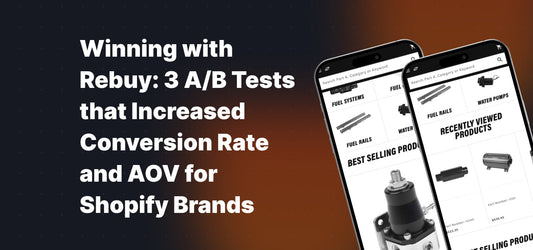Table of Contents
Get useful eCommerce stuff
The Importance of a Clear Brand Message
Throughout this blog, we will discuss the less-is-more approach when it comes to the UI/UX design of a Shopify store. UI/UX design is responsible for ensuring a business’ store and products can be used effectively by the target audience.
It can be tempting to try and promote sales by pulling out all the bells and whistles, but trying too hard can have the opposite effect. Study after study has proven that simple website design leads to increased conversion rates than websites with excessive ornamentation.
Research suggests that the average user will take around 20 seconds on a website to form a first impression; and that first impression is likely to be a crucial deciding factor over whether you make the sale or your competitor does. This 20 second window means keeping it simple will help the users focus on the brand's message and what you are trying to offer without drawing their attention to less relevant information.
What are the benefits of a simple website design?
1. Smaller bounce rate. Higher conversion rate
There is a reason why many successful companies have opted for less information on their website, because it works. The ‘less is more’ concept applies to both the layout and the contents of the site. The art of prioritising and portioning the content, if done well, can help you engage your users more, leading to lower bounce rates as well as higher conversions.
2. Easier to choose. Easier to use
There is a term called the paradox of choice. The phrase, in short, means that having too many options makes it difficult for people to be satisfied with their choice. That perfectly translates to navigation. The simpler it is, the easier it is for the user to find what they need.
3. Eliminates distractions. Reduces friction
The Google homepage is designed entirely around its central search function. Anything unnecessary to the function, other than branding, was eliminated. Branding is even more prominent. Not only is it one of the few visual elements on the page, but because the page remains uncluttered, it’s not distracting. Google’s minimalist philosophy is a great one to follow to improve user experience and promote engagement.

4. Here are a few more benefits.
Increasing speed - less load time and faster site reduces friction
Error proofing - less complex code means fewer opportunities for the site to crash
SEO friendly - not a lot of clutter in the code is easy for search engine bots to crawl
Easy recall - it's easier for people to remember less information than more
How to Simplify your Design Process
1. Only include essential content
Content is the main focus for a user, and by simplifying this information down to enhance the user journey, we can ensure a better shopping experience. Too much content can become distracting for a user, leading to visitors leaving your store. Finding the balance of having informative content without having too much unnecessary information is critical.

EcoKids Planet, Homepage Banner
2. Use of white space
Having the perfect balance of white space is essential for any design. When it comes to UI/UX design, white space is what highlights the content. For example, ensuring there is enough space around each content block or product card will enhance the shopping experience for the user.
3. Photos and Graphic Illustrations
Images are a significant part of web design as they can portray more emotion and thoughts than words. The type of photos or illustrations you use will convey your brand's tone of voice. With that said, if the image is too crowded, this can become distracting and portray a message that you don’t want to. This is why for one of our clients we opted for imagery that is extremely clear.

Friska Desk, Shop by Category
4. Bold typography
When it comes to the page content, ensuring you have consistent H1s, H2s and H3s is very important. Having bold titles and the contrast of body copy will emphasise the page content and allow the user to easily find the information they are looking for.
Our Outlook on Simplicity in UI & UX
All things considered, if you want your website to perform well, start by finding the primary goal of each page. This will help you establish the basic hierarchy of content. By manipulating layout, order of content, white space, the visual weight of elements, and colours. You can lead customers to the most critical actions first. You can hint at secondary actions and mention other things based on the hierarchy you have established before. Once you're done, consider removing items and see how that affects your site. Maybe the FAQ doesn't need to take up so much space. Maybe move the excessive description under your [Add to Cart] button; so the Primary action is easier to locate.
Considering these actions will reduce the amount of content on your page and make it easier for users to navigate your store. Lastly, a simple and appropriate navigation system is vital for making your target audience’s user journey as easy as possible.
Want to stay in the loop? Sign-up below and keep up to date with our 12 Days of UX. You don’t want to miss these!








